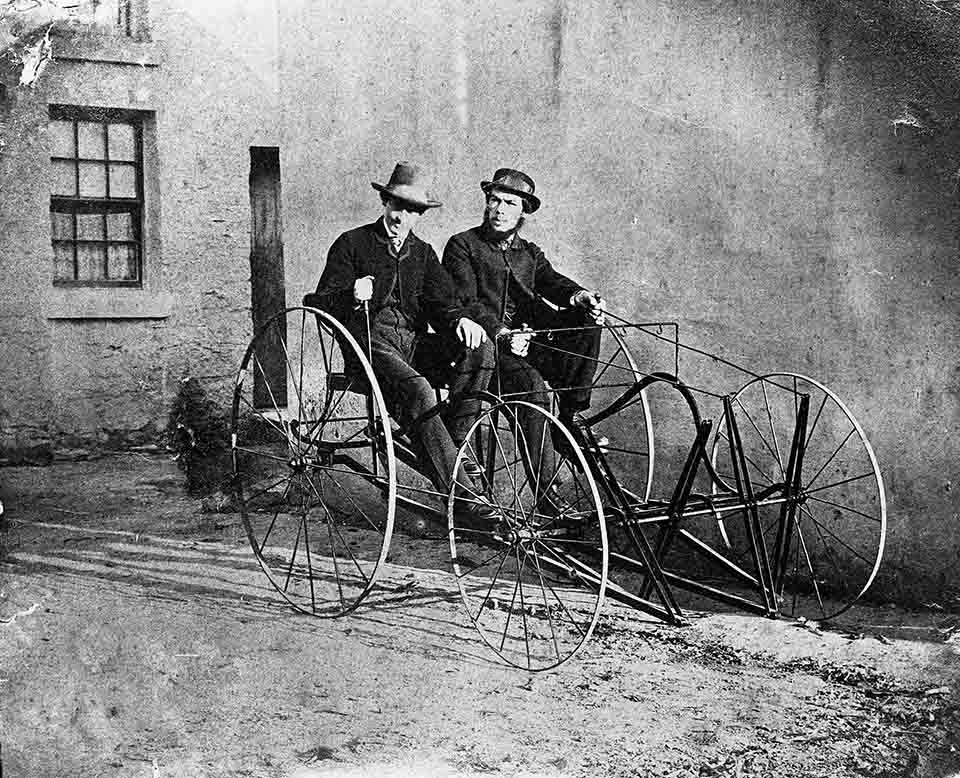The Dictionary of Sydney was archived in 2021.
The Dictionary of Sydney was archived in 2021.
On your bike!
 Madame Franzina, bicycle performer 1876 , courtesy Mitchell Library, State Library of NSW (PXA 362/v3/28r)
Madame Franzina, bicycle performer 1876 , courtesy Mitchell Library, State Library of NSW (PXA 362/v3/28r)
Listen to the whole conversation with Lisa and Tess on 2SER here
On the right is a studio photograph from the State Library's collections of Madame Adela Franzini (or Franzina), a bicycle performer, that was taken in 1876. Madame Franzini travelled widely on the colonial theatrical circuit, appearing in Sydney and other centres around the country from the 1870s to 1890s. A reviewer in a New Zealand paper in 1876 said the bicycle she used was 'of the ordinary description, except that the wheels are toed with indiarubber bands so as to prevent rattle or noise'. They also pointed out that: 'We need hardly say that she rides on one side, and therefore only uses one foot with which to propel the lever'.[1] Her ladylike riding style not withstanding, her appearance in Ballarat in the same year caused 'a sensation among a certain section of the Ballarat clergymen'.[2] Another review of her theatrical appearance in Calcutta in 1890 was also very enthusiastic: 'The most striking feature of the performance given in the Theatre Royal (in Calcutta) on Saturday (March 1) night consisted in the feat of Madame Franzini on the bicycle. The lady is by no means a stranger to Calcutta, having made her appearance some years ago in one of the circuses, but since then she has reached the height of perfection as a bicyclist. The feats she executes are astonishing, especially when we consider her weight and the dexterity required to manipulate the machine in the performance of difficult and fantastic evolutions. The best item in the programme, which as far as her portion goes was far too short, was her circling through a maze of lighted bottles without touching one or being in the least inconvenienced by the serried flames.'[3] Henri L'Estrange, The Australian Blondin 1876 by George Willetts, courtesy of the State Library of Victoria (H96.160/2603)
Henri L'Estrange, The Australian Blondin 1876 by George Willetts, courtesy of the State Library of Victoria (H96.160/2603)
 Final heat of the Grand Bicycle Steeplechase - the water jump. Anniversary Day sports at the Albert Ground, Redfern 26 January 1870, Illustrated Sydney News, 17 February 1870 p344
Final heat of the Grand Bicycle Steeplechase - the water jump. Anniversary Day sports at the Albert Ground, Redfern 26 January 1870, Illustrated Sydney News, 17 February 1870 p344
 Norman Selfe (with beard) and Edmund Wolstenhome on velocipede invented by Selfe c1870s, courtesy of the Deer Family
Norman Selfe (with beard) and Edmund Wolstenhome on velocipede invented by Selfe c1870s, courtesy of the Deer Family
 George Street, near the GPO c1900 By Kerry & Co, courtesy Mitchell Library, State Library of New South Wales (PXA 448, 9)
George Street, near the GPO c1900 By Kerry & Co, courtesy Mitchell Library, State Library of New South Wales (PXA 448, 9)
 Billie Samuels at Martin Place on the Malvern Star bike before riding to Melbourne, 4 July 1934, by Sam Hood, courtesy Mitchell Library, State Library of NSW (Home and Away - 4237)
Billie Samuels at Martin Place on the Malvern Star bike before riding to Melbourne, 4 July 1934, by Sam Hood, courtesy Mitchell Library, State Library of NSW (Home and Away - 4237)

Categories
Blog
2SER Breakfast
cycling
Lisa Murray
sydney history
Tess Connery
women
World Bicycle Day

